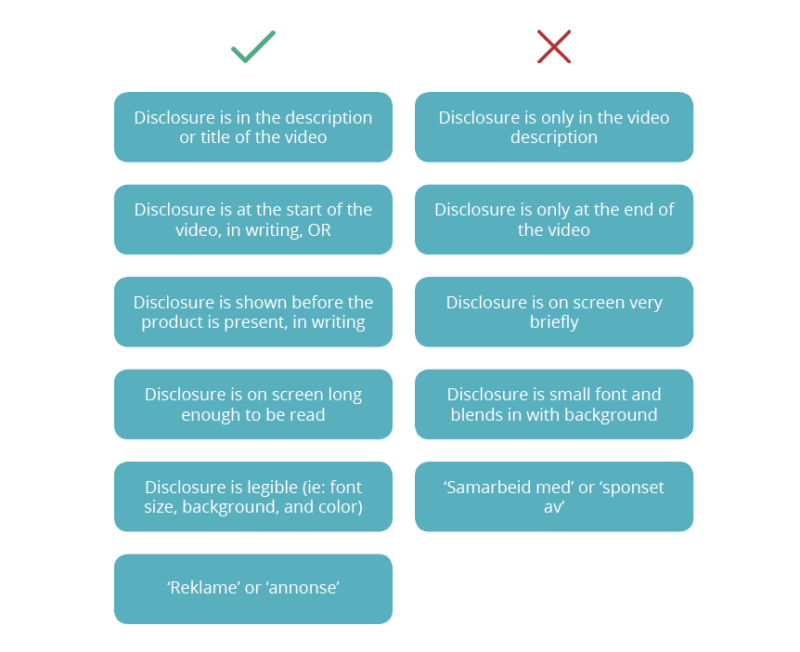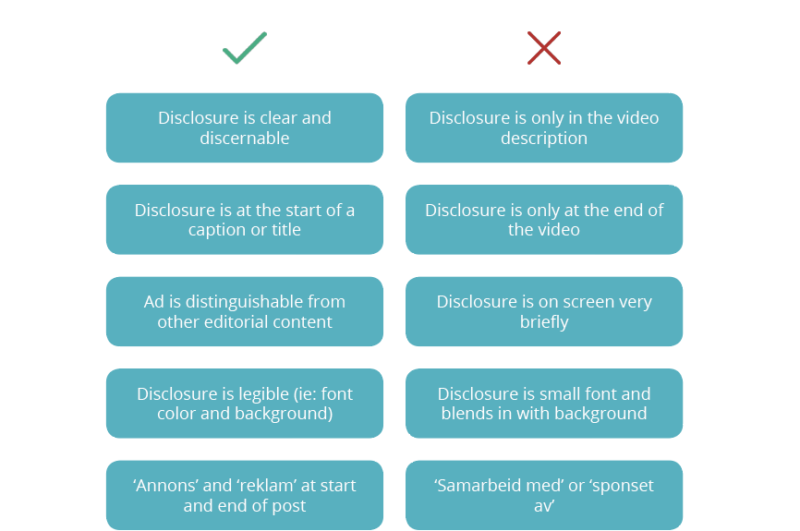
insights
How to Disclose Sponsored Content in the Nordics
To avoid misleading consumers, brands and creators must be transparent with their collaborations
To avoid misleading consumers, brands and creators must be transparent with their collaborations. Consumers may find it difficult to differentiate between advertorial content (sponsored content) and editorial content (non-commercial content). In order to protect consumers from unfair advertising practices, it’s important that brands and creators are upfront about their partnerships by including a disclosure along with their sponsored content.Disclosure guidelines differ from country to country. We’ve outlined guidelines on how to disclose properly for Norway, Sweden, and Finland. You can also find guidelines for how to disclose sponsored content in the UK and US. These guidelines are up to date as of 22 August 2022. Regulations by country:Jump to NorwayJump to SwedenJump to FinlandJump to Advertising at children in the Nordics
Norway
In Norway, the 'Forbrukertilsynet' monitors advertising on blogs, Facebook, Instagram, Twitter, and Snapchat. The 'Mediatilsynet' monitors advertising practices on Youtube. Jump to blogs, Facebook, TikTok, Instagram, Twitter, and Snapchat regulationsJump to Youtube regulations
Blogs, Facebook, TikTok, Instagram, Twitter, and Snapchat regulations
The 'Forbrukertilsynet' considers content to be an ad if creators:
- Receive monetary compensation or benefits for a post.
- Are loaned a product or service, receive them for free, gain access to discounts, or partake in an arrangement or travel in return for a review.
- Have a deal or relationship with a business to feature them on your social media for exposure. This applies when creators are, for example, a brand ambassador.
- Host a competition or giveaway for a business.
- Share a link and get paid per click or sale.
- Run their own business and self-promote their products.
How should ads be disclosed?
According to the guidelines, sponsored content must be recognized as an ad immediately, so it's important that creators add disclosures to their content.

Other things to consider:
- If creators share ad links ('annonselenker') along with their sponsored posts, they must mark the links as 'annonselenker' and their posts as 'reklame.' Consumers must be able to understand what content, in its entirety, has been sponsored.
- Creators should be consistent with how a post is marked as an ad. If many different methods are used, disclosures can become unclear.
- If the sponsored content is in Norwegian, the disclosure must also be in Norwegian.
- If creators reshare sponsored content on other social media channels, they need to include a disclosure on those channels.
- If they have followers under 18-years-old, they must take extra care and clearly communicate what they're advertising.
- If creators retouch or add filters to images of themselves for a sponsored post, they must label it. You can do this with a standard mark produced by Forbrukertilsynet. You can download this mark here.
Some examples of how to disclose well on different platforms
- Blog: Content should be marked as an ad at the very top of the page, so it’s the first thing readers see.
- Instagram: Disclosures are most clear when the photo itself is marked as an ad. #reklame or <<reklame>> can also be added at the very start of your caption.
- Twitter: The disclosure should be the first word in the tweet. If a sponsored blog post is shared on Twitter, the tweet and blog post must include a disclosure.
- Snapchat: Content should be marked with #reklame or <<reklame>> as the first word in the text.
- TikTok: Content should be labeled, either in the video, title, or at the start of the caption, with something that clearly identifies it as a sponsored post. For example, ‘advertisement’’ or ‘#advertisement.’
Learn more about regulations on Blogs, Facebook, TikTok, Instagram, Twitter, and Snapchat here and here.
YouTube regulations
The ‘Mediatilsynet’ has outlined regulations specifically for video bloggers and Youtube, which are different from the guidelines listed above.If creators earn money or receive benefits for presenting products or services in their video, they must include a disclosure. ‘Kringkastingsloven’ has rules on disclosing ads (‘reklame’), sponsorships (‘sponsing’), and product placements (‘produktplassering’).How creators disclose their brand partnership depends on the type of videos they create. But generally, it should be easy for viewers to understand which videos contain sponsored content.
Ad (‘reklame’) or Product Placement (‘produktplassering’)
If creators are being paid to present a product or service in a video, it’s either an ad (‘reklame’) or product placement (‘produktplassering’).Alternative A: The product is the main focus in the video = Ad (‘reklame’)If a product or service is the main focus of the creators’ video, or if creators are recommending viewers to purchase the product or service, their video is an ad (‘reklame’). Their video must comply with the following:

Link to website = Ad (reklame)If creators share a link to a brand’s website where their product or service can be purchased, it’s considered an ad (‘reklame’). Creators must, in writing, disclose that it is an ad. If they are compensated when someone makes a purchase using their link, they should inform their audience of this.Creators can disclose that the link is an ad by using ‘reklame’ or ‘annonse’ by the link.Alternative B: Product is not the main focus of the video = Product Placement (‘produktplassering’)If the brand’s product or service is not the main focus of the video and is not discussed in the video, but is visible or displayed, then the creators’ video contains product placement. They need to add a disclosure, in writing, on a screen at the beginning and end of the video. Creators must ensure that the disclosure is:
- Visible on screen for a minimum of 6 seconds.
- Big enough font size.
- Visible against the background it’s on so it can be read.
The disclosure must be written as follows: <<P – Inneholder produktplassering>> and included at the beginning and end of the video.
Sponsorships (‘sponsing’)
If creators are paid to produce a video, but the video doesn’t contain advertorial content, the video is sponsored (‘sponsing’).If creators are being sponsored by a company, they must disclose who their sponsor is. With sponsorships, the company paying the creator cannot influence the content of the video, and the company’s products or services cannot be mentioned. To disclose sponsorships, creators must:
- Identify the sponsor at the beginning and/or end of the video.
- Identify the sponsor orally or in writing
They can, for example, write: ‘Sponset av X (brand)’ at the beginning of the video, or ‘Takk til X (brand) for bidraget.’
What happens if creators don’t disclose properly?
Consequences can include receiving a violation fee penalty, a compulsory fine, or a time-limited ban on advertising.You can learn more here.
Sweden
When is a post considered marketing?
The ‘Konsumentverket’ monitors advertising practices in Sweden. All marketing is subject to the regulations that have been laid out in ‘Marknadföringslagens bestämmelser.’ According to the guidelines, creators can give recommendations on products or services, but if they're being compensated in some way, the Marketing Act applies. Compensation can include:
- Money
- Products
- Services
How do creators disclose?
According to the guidelines, sponsored content must be recognized as an ad immediately, so it's important that creators add disclosures to their content.


What happens if creators don’t disclose properly?
If these regulations are violated, a warning will be sent. If the warning is violated, both brand and creator can be sentenced by a judge to pay a fine.You can learn more here and here.
Finland
What are the guidelines?
The ‘Kilpailu- ja kuluttajavirasto’ monitors advertising practices in Finland. According to their guidelines, consumers have the right to know whether there’s been attempts to influence them commercially, so ads must be easily recognizable as ads. To do this, disclosures should be published along with the sponsored content. The term, "marketing," refers to commercial communications, such as:
- Advertising
- Various sales promotion methods, such as discounts and promotional games

Product placement occurs when you receive compensation for placing products or services in an audiovisual program. This is generally forbidden. It's permitted in films, serials, sporting programs, and light entertainment programs. If creators include product placement in a permitted program, they must disclose this very clearly.You can learn morehere andhere.
Advertising at children or young adults in the Nordics
In the Nordics, marketing rules are generally stricter when it comes to children and young adults because they are more susceptible to the effects of ads. They have a harder time distinguishing advertorial content from editorial content.If creators’ audience includes children or young adults, the disclosure must be in a language they can understand. Promoting directly to children is forbidden. Creators cannot ask them to purchase something or persuade them to ask their parents/other adults to buy them a product.Disclaimer: This post is meant to provide you with guidelines on how you can avoid breaking marketing laws and regulations, and it should not be considered legal advice. If you’re unsure about how to disclose, we recommend that you reach out to the consumer authority in your country.
inzpire.me
inzpire.me is an influencer marketing platform that connects brands with creators across the globe. Ready to launch a campaign? Schedule a call today!

Sign-up to our newsletter
Become an expert in influencer marketing
You may also like

Top 7 Benefits of Influencer Marketing

How to find the right influencers for your brand in 2025: Say hello to AI Creator Matching
